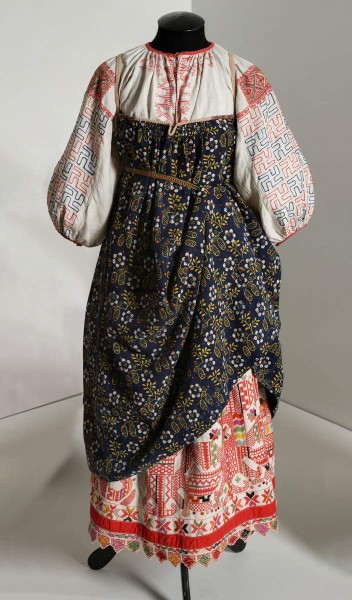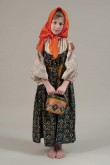Maiden’s Costume
Kargopol District, Olonets Gubernia. 19th century
- Flax, double-sided embroidery with cotton threads, cube printed fabric on flax canvas, fabric, embroidery with cotton and wool threads, wool, weaving on boards
- Н-2322; В-7807; В-7990; Т-3890
Shirt (sleeves)
First half of the 19th century
Flax canvas, double-sided embroidery with cotton threads
Sarafan
Cube printed fabric on flax canvas
Skirt
Fabric, embroidery with cotton and wool threads
Sash
Wool, weaving on boards
The bast-fiber basket, decorated with bright embroidery by a local craftsperson, was made for a little girl, as shown by the message on the edge reading “This belongs to 5-year-old Alexandra Ivanovna Kobeleva”.
Teenage girls’ clothes were very similar to the older women’s. Clothes for younger girls were made according to the local fashion or from cheap factory cloth, or were made from their mothers’ or elder sisters’ cast-offs. This tradition was not the result of poverty or frugality; it was thought that the clothes of parents would protect the young, frail soul and the body of a child from curses, troubles and disease… As they grew up the girls’ dress became more expensive and elegant. The brightest and most decorated clothes were for maidens of marriageable age and young brides-to-be.
Kargopol District, Olonets Gubernia is an area rich in Russian embroidery, probably with no equal anywhere else in Russia. All parts of the female costume were decorated with embroidery: shirts, sarafans, underskirts, headdresses and kerchiefs.
The tops of shirt sleeves were embroidered with small rectangular patterns together with small thick patterns, resembling a miniature mosaic. The pattern glistens with tiny spangles and the iridescent silk used in parts of the embroidery is alight with flame.
The patterns on skirts, valances and towels can be so complex that they resemble mysterious puzzles with many intertwined motifs.



